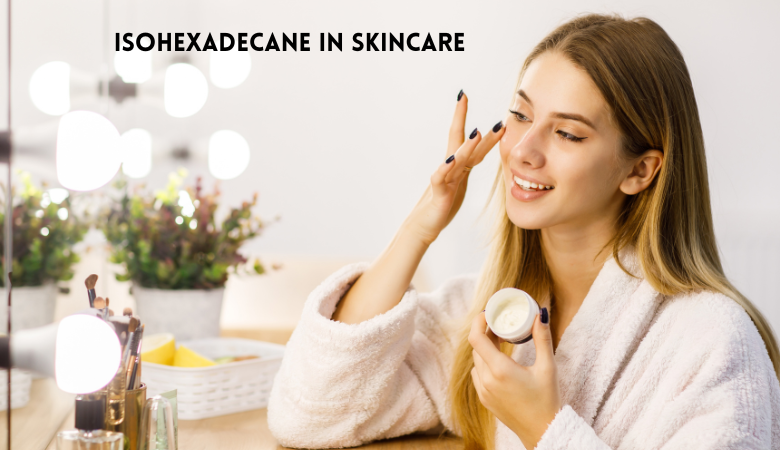Isohexadecane in Skincare: 7 Surprising Benefits You Need to Know

Isohexadecane in Skincare: innovations evolve rapidly, and ingredient names like “isohexadecane” might sound unfamiliar or even intimidating. But don’t be fooled by the scientific name—isohexadecane is one of the unsung heroes in modern skincare. Found in various creams, lotions, and cleansing oils, isohexadecane serves a pivotal role in enhancing product performance, improving skin feel, and delivering silky-smooth textures.
So, what makes isohexadecane so compelling for both skincare formulators and users alike? Let’s dive into the depths of this multifunctional ingredient and uncover why it’s gaining popularity across the cosmetic industry.
The Origins and Chemistry of Isohexadecane
Isohexadecane in Skincare is a branched-chain hydrocarbon derived from petroleum. Structurally, it’s part of the isoparaffin family and often used for its emollient and solvent properties. In terms of chemical behavior, isohexadecane is non-polar, which allows it to dissolve oils and other lipophilic (oil-loving) ingredients, making it a perfect carrier in cosmetic formulations.
Interestingly, despite being derived from petroleum, isohexadecane undergoes rigorous purification processes to make it cosmetic-grade, rendering it safe and stable for topical use. Its low molecular weight and high volatility make it evaporate quickly, leaving behind a light, non-greasy film.
How Isohexadecane Works on the Skin
When applied to the skin, isohexadecane doesn’t penetrate deeply. Instead, it forms a breathable barrier that helps lock in moisture and protect against external aggressors. It smooths out skin texture by filling in fine lines and creases temporarily and enhances the glide of other ingredients.
More importantly, it acts as a vehicle that carries active ingredients deeper into the epidermis without disturbing the skin’s natural barrier. This means better absorption without the risk of clogged pores—music to the ears of anyone with acne-prone or oily skin.
Moisturizing Properties of Isohexadecane
While isohexadecane isn’t a humectant like hyaluronic acid, it works as an effective emollient. It seals hydration into the skin by reducing transepidermal water loss (TEWL). When used in tandem with hydrating ingredients like glycerin or squalane, isohexadecane magnifies their effects.
Unlike traditional heavy moisturizers, formulations with isohexadecane deliver moisture without the greasy after-feel. This makes it an excellent option for people who want a feather-light hydration experience.
Isohexadecane and Skin Barrier Protection
Our skin barrier is our body’s first line of defense, and maintaining its integrity is essential for preventing dehydration, irritation, and infection. Isohexadecane supports this barrier by forming a soft, protective layer that reduces exposure to pollutants and allergens.
This protective quality becomes especially beneficial for individuals with compromised skin—such as those with eczema or rosacea—where traditional oils or waxes may feel too heavy or occlusive.
Lightweight Texture and Non-Greasy Feel
One of isohexadecane’s standout qualities is its silky, dry-touch finish. It offers an almost powdery feel that instantly makes skin appear smoother and softer without that dreaded oily residue.
This makes it especially useful in mattifying skincare products or foundations designed for oily or combination skin. You get the benefits of a smooth finish with none of the stickiness.
Isohexadecane as a Solvent in Formulas
In cosmetic chemistry, solvents are crucial. Isohexadecane helps dissolve other ingredients—like active botanicals, essential oils, or silicones—making the final formula more homogenous and effective.
Its solvency also improves ingredient stability, ensuring your product works as intended from the first application to the last drop.
How Isohexadecane Improves Product Spreadability
Ever wonder why some products glide over your skin so smoothly? Thank isohexadecane. It drastically improves the spreadability of creams and lotions, allowing a little product to go a long way.
This property also ensures an even application, reducing the risk of patchiness in makeup or uneven distribution in sunscreen.
Isohexadecane and Enhanced Skin Absorption
Despite its non-penetrating nature, isohexadecane acts as a “facilitator” for other ingredients. By enhancing the overall consistency and fluidity of a product, it helps active ingredients reach where they’re needed most—your skin’s deeper layers.
The result? Better performance without added irritation.
Isohexadecane vs Silicones: What’s the Difference?
Silicones like dimethicone have long dominated the skincare space, but isohexadecane is a strong competitor. While both offer a smooth, silky texture, isohexadecane absorbs more quickly and doesn’t leave behind a film that can sometimes feel heavy or cause breakouts.
Plus, isohexadecane is less likely to cause build-up, making it more suitable for daily wear.
Isohexadecane vs Mineral Oil in Skincare
Though both ingredients come from petroleum, their skincare roles differ significantly. Mineral oil is heavier, creating a more occlusive barrier ideal for extremely dry skin but potentially problematic for acne-prone users.
Isohexadecane, on the other hand, offers similar moisture-sealing benefits with a much lighter feel, making it a versatile alternative for a wider range of skin types.
Is Isohexadecane Safe for All Skin Types?
In general, yes. Isohexadecane is considered non-comedogenic, hypoallergenic, and non-irritating. Clinical safety data supports its use even for sensitive or compromised skin.
That said, it’s always wise to patch-test new products, especially if you have known sensitivities.
Isohexadecane and Acne-Prone Skin: Is It Comedogenic?
One of the biggest misconceptions about oil-derived ingredients is that they always cause breakouts. Isohexadecane debunks that myth. Its light texture and fast absorption make it suitable even for oily and acne-prone skin.
Moreover, because it doesn’t clog pores or leave residue, it can help balance oil production when used consistently.
Does Isohexadecane Cause Irritation or Allergies?
Allergic reactions to isohexadecane are rare. In fact, it is often used in formulations meant for reactive or allergy-prone skin. However, as with all ingredients, it’s best used within balanced formulas crafted by reputable brands.
Environmental Impact of Isohexadecane
While effective, isohexadecane’s petroleum origins raise environmental concerns. It’s not biodegradable and can contribute to pollution if not managed properly. That said, it is often used in small quantities and has a longer shelf-life, which may reduce overall waste.
The beauty industry is gradually exploring plant-derived alternatives, but for now, isohexadecane remains a valuable, if imperfect, ingredient.
Common Skincare Products Containing Isohexadecane
You’ll typically find isohexadecane in:
-
Makeup removers and cleansing balms
-
Long-wear foundations
-
Lightweight moisturizers
-
BB and CC creams
-
Skin primers
-
Sunscreens
-
Hair styling products (as a conditioning agent)
Isohexadecane in Facial Cleansers and Makeup Removers
Its dissolving power makes isohexadecane a favorite in oil-based cleansers. It can break down even waterproof makeup and sunscreen without irritating the skin or eyes.
That’s a major win for anyone who wants effective cleansing without the need for harsh surfactants.
Why Luxury Brands Use Isohexadecane in Moisturizers
Luxury skincare brands appreciate the elegant finish isohexadecane provides. It allows for rich-feeling moisturizers that feel weightless on application—combining performance and experience in one swipe.
How Much Isohexadecane is Too Much?
Typically, concentrations range from 2–15% in cosmetic products. Using too much isohexadecane on its own isn’t advised, as it may disrupt the skin barrier. Always follow product directions and avoid mixing concentrated ingredients unless you’re a professional.
How to Identify Isohexadecane on Ingredient Lists
Look for names like:
-
Isohexadecane
-
Hydrogenated polyisobutene (related derivative)
-
C16-isoalkane
It’s often listed near the top in cleansers and midway in moisturizers or makeup.
Should You Use Isohexadecane Daily?
If it’s part of a well-formulated product, absolutely. Daily use can help maintain skin hydration, enhance makeup performance, and improve overall texture. Just be mindful if you’re also using other actives like retinoids or exfoliants.
Rise of Isohexadecane in Clean Beauty Formulations
Though controversial for its petroleum base, isohexadecane’s safety profile has earned it a spot in many clean beauty lines. Some brands opt for renewable alternatives, but many still favor isohexadecane for its unmatched texture.
Consumer Opinions and Dermatologist Perspectives
Many dermatologists support its use, especially in gentle skincare lines. Consumers often report improved product feel, better skin hydration, and less irritation when switching to formulas containing isohexadecane.
Why Formulators Love Isohexadecane
From emulsions to serums, formulators value isohexadecane for its multi-tasking nature. It enhances texture, improves efficacy, and blends seamlessly with both water-based and oil-based ingredients.
Future of Isohexadecane in Skincare Innovation
Research is underway to find eco-friendlier alternatives that match isohexadecane’s properties. Until then, it continues to hold its ground as a high-performance ingredient in both drugstore and high-end skincare.
Can You Use Isohexadecane in Homemade Skincare?
Technically yes, but it’s not widely available in consumer-friendly formats. If you’re into DIY skincare, safer and more accessible emollients like squalane or jojoba oil may be better options.



